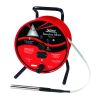Heron H.OIL Oil/Water Interface Meters
The Heron H.OIL is a portable oil/water interface meter that measures the thickness of DNAPL and LNAPL layers as thin as 1 mm.
Features
- 5/8" field-replaceable stainless steel probe
- High strength polycarbonate reel with corrosion-resistant stainless steel fittings
- Water and dust proof encapsulated electronics
- Free ground shipping
- Expedited repair and warranty service
- Lifetime technical support
- More
Overview
The Heron H.OIL interface meter is a precision instrument used by professionals involved with the monitoring and remediation of groundwater contaminated with oil products. The meter will accurately measure the thickness of LNAPL layers floating on the water table as thin as 1mm. It will also detect and measure sinking layers of DNAPL.
Lightweight and Durable
With its slim 5/8" probe, the H.OIL is ideal for wells, piezometers and direct push equipment as narrow as 3/4". Certified intrinsically safe, the meter is suitable for use in storage tanks and areas where explosive gases may be present. The stainless steel probe and a Kynar jacketed, NTS-certified tape will withstand attacks by hydrocarbons, solvents and other contaminants. The meter is backed by a 10-year limited warranty, and the replaceable probe comes with a 1-year warranty.
- Premium Stainless Steel Kynar Coated Tape
- CSA Intrinsically Safe Certification w/ Class I, Groups A,B,C and D in zones 0 & 1
- 3/4” (19.2mm) Interface Probe (IP68)
- Electronic Panel with audio and visual signals (Fully Encapsulated to IP65)
- Grounding Lead
- Vinyl, ergonomic holding grip
- 9V Battery
- Backpack Carrying Case w/ adjustable straps, laptop & notepad pouches
In The News
From Hurricanes to Florida’s Red Tides: Monitoring the Southwest Gulf Coast
Nearly every year, southwest Florida is blighted by harmful Karenia brevis blooms–known colloquially as Florida red tides. These harmful algal blooms (HABs) form over the West Florida shelf and are pushed shorewards by winds and currents. Once in touching distance of the coast, they often intensify, fed by land-based runoff, anthropogenic nutrients, and decomposing marine life killed by toxins produced by these red tides. Red tides have become more severe and persistent over the past 20 years, causing major environmental and economic damage.
Read MoreWave-Powered Buoy Deployed in Puget Sound
While the development of solar-powered monitoring systems has improved access to real-time environmental data, solar power is still limited by low light conditions, such as poor weather, nighttime, or high-latitude environments. To supplement these incumbent power solutions at sea, Ocean Motion Technologies has developed a small-scale ocean wave energy system that can be directly integrated with existing data buoy platforms. Not only does wave energy supplement solar power during periods when the buoys are limited by light availability, but it also allows data buoys to perform beyond their current power capacities.
Read MoreLong-Term Monitoring in the Chautauqua Lake Watershed
With a widely developed shoreline, Chautauqua Lake experiences influxes of non-point source pollution that have historically impacted the health of the lake. The Chautauqua Lake Association (CLA) has been monitoring the lake for over two decades, reporting on changes that have occurred over the years. A pair of local lake advocates, Jane and Doug Conroe, have lived on the lake for over 40 years and have played an important role in establishing monitoring programs and facilitating consistent data collection throughout the watershed. Doug has been involved with the Chautauqua Lake Association (CLA) since the pair moved to the area in 1980, and is currently serving as the Executive Director.
Read More




















